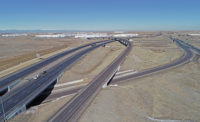SouthEast Connector Phase II
Sparks and Reno, Nev.
Best Project
Owner/Developer: Regional Transportation Commission of Washoe County
Lead Design Firm: Jacobs CH2M Hill
General Contractor: Granite Construction Co.
Subcontractors: Associated Concrete Pumping; CMC Rebar; Lumos & Associates; MAPCA Surveys Inc.; Mountain Pacific Inc.; Nevada Barricade and Sign Co.; PAR Electric; Pavement Recycling Systems; Penhall Co.; Ralph L. Wadsworth Construction Co.; Sierra Nevada Construction Inc.; Signature Landscapes; Soil-Tech; Tensar; Tholl Fence Co.; Viking Drillers Inc.; Western Partitions Inc.
Nevada’s SouthEast Connector is a six-lane roadway in Truckee Meadows that connects Reno and Sparks. Along with reducing congestion on other roadways, it has dedicated bike lanes and a 10-ft-wide, multi-use pathway separated from the roadway. The five-mile, six-lane arterial highway traverses an ecologically sensitive area. Built in a flood zone, it includes five bridges, 17 box culverts, two new and two reconstructed signalized intersections and several sound walls.
Brian Roll, Granite Construction Co. project manager, says he’s heard positive feedback from residents who say the connector reduces their daily commute by 15 to 20 minutes.
Completed in July 2018, the project was first proposed in 1965. Previously, there hadn’t been much public support for it, Roll says. But population growth in the Reno metro area, along with development of the Tahoe Regional Industrial Center, changed that. According to developers, the new roadway enhances community access and facilitates commercial transportation; allows community engagement through a safe, scenic and mixed-use trail; and mitigates potential flood damage to residents and businesses. Motorists, bicyclists and pedestrians use aesthetically enhanced “porkchop” traffic islands with stamped patterns and colored concrete. Median islands include decorative rocks in different colors, sizes and shapes placed along the alignment.
Workers cultivated 150 acres of new wetlands (to replace the seven or eight taken during construction), sequestered contaminated soils, disposed of 4 million tons of trash left on open land and removed hundreds of acres of noxious weeds. The road was built using onsite materials, including a 15% recycled asphalt product. Roadside slopes were designed with minimal barrier rails, which help preserve views of the surrounding hillsides. Other aesthetic touches include culvert headwalls with stamped patterns and a colored stain. Bridges also feature colored stains.
A functional design feature was one-way wildlife gates. Deer and wild horses are prevalent in the area, so in addition to appropriate fencing, wildlife gates placed at regular intervals allow animals to exit the roadway and not become a hazard.
Back to "ENR Southwest's 2019 Best Projects: Innovation, Skillful Renovations Lauded"





-04_ENRready.jpg?height=200&t=1668199635&width=200)
Post a comment to this article
Report Abusive Comment